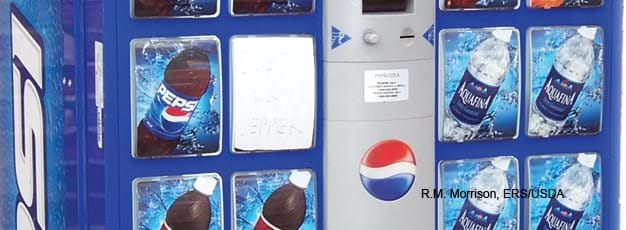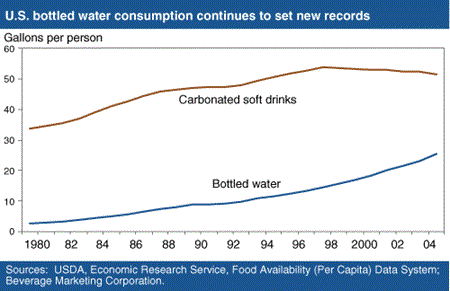Soft Drink Companies Make Splash in Bottled Water

U.S. consumers now drink more bottled water than any other beverage, except carbonated soft drinks. Since 1998, per capita consumption of carbonated soft drinks has fallen slightly, while bottled water consumption continues to set new records. From 1997 to 2005, per capita consumption of bottled water increased by 90 percent to 25.4 gallons—17 percent of nonalcoholic beverage consumption.
The four largest suppliers’ share of bottled water sales rose from 52 percent in 1997 to 63 percent in 2002, a 21-percent increase. Such a large increase in sales concentration occurred despite rapid demand growth, which can attract new suppliers and slow increases in concentration. In the poultry industry, for example, the four-firm concentration ratio rose by 17 percent from 1987 to 1992, while the hog slaughter concentration ratio increased by 43 percent. Over the same period, ERS’s food availability data, a proxy for consumption, show a 19-percent increase for poultry, compared with a 7-percent gain for pork.
Leveraged by their extensive bottling and distribution networks, Pepsi-Cola and Coca-Cola entered the bottled water industry in the mid- to late-1990s and quickly ranked among the top four suppliers of bottled water in the U.S. Both companies distribute their bottled water brands through the same channels that carry their soft drinks. The companies have also relied on their own brand-building capabilities. Pepsi introduced Aquafina in the mid-1990s and, by 1999, had become the fourth-largest supplier of bottled water with a 5.5-percent market share. In 1999, Coke introduced the Dasani brand, supported by the largest advertising budget in the bottled water industry. In 2004, shares of Pepsi and Coke reached 11.3 percent and 10 percent of the bottled water market, respectively. The other two leading suppliers of bottled water, European-based Nestlé and Groupe Danone, also continued to increase their U.S. market share by acquiring North American companies and constructing new plants in the United States
The U.S. Food Marketing System: Recent Developments, 1997-2006, by Stephen Martinez, USDA, Economic Research Service, May 2007


